Home is more than just a physical space—it’s a feeling, a sanctuary, and a foundation for identity. Across cultures, the concept of home carries deep emotional weight, shaping how we view relationships, security, and personal growth. In this essay, we explore the multifaceted nature of home, examining its role in our lives and the values it represents.

The Emotional Anchor of Home
For many, home is synonymous with family. It’s where we experience our first bonds, learn unconditional love, and develop a sense of belonging. The laughter shared around the dinner table, the quiet comfort of a parent’s reassurance, or the warmth of a sibling’s support—these moments create an emotional anchor that stays with us throughout life.
Psychologists emphasize the importance of a stable home environment in fostering resilience. Children raised in nurturing homes often exhibit stronger emotional intelligence and adaptability. Even as adults, returning to a familiar space can evoke a sense of safety, allowing us to recharge amid life’s challenges.
Home as a Cultural Mirror
Cultural traditions heavily influence how we perceive home. In some societies, home is a collective space where extended families live together, emphasizing interdependence. In others, individualism shapes smaller, nuclear households. Yet, regardless of structure, home remains a place where cultural values are passed down—through stories, rituals, and shared meals.

For example, in many Asian cultures, ancestral altars or family heirlooms symbolize continuity between generations. In Western households, holiday traditions like decorating Christmas trees or hosting Thanksgiving dinners reinforce familial bonds. These customs remind us that home is not just a location but a living repository of heritage.
The Evolving Definition of Home
Modern lifestyles have reshaped the idea of home. With remote work and global mobility, physical spaces are no longer the sole determinant of belonging. Digital connections allow people to maintain close ties across distances, challenging the notion that home must be fixed in one place.
Some argue that home is wherever we find meaningful connections—whether with friends, partners, or communities. A student studying abroad might call a shared apartment “home,” while a digital nomad may feel at ease in co-living spaces worldwide. This flexibility reflects our innate desire for connection, even when traditional structures shift.

Challenges to the Ideal of Home
Not everyone experiences home as a haven. For some, it may be a place of conflict, loneliness, or instability. Economic pressures, migration, or family discord can disrupt the sense of security home should provide. Acknowledging these realities is crucial to understanding the full spectrum of human experiences.
Efforts to create inclusive communities—such as shelters for the homeless or support groups for fractured families—highlight the universal need for belonging. These initiatives reinforce that home isn’t just about four walls; it’s about dignity, acceptance, and the right to feel safe.
Personal Reflections on Home
Growing up, my childhood home was a small house with a sprawling garden. The scent of rain on soil or the sound of my grandmother’s stories still brings me comfort. Now, as an adult living in a city apartment, I’ve learned that home transcends place. It’s in the friendships that feel like family, the routines that ground me, and the quiet moments of contentment.

Perhaps home is best defined by its ability to evolve with us. It’s not static but a reflection of our journey—a blend of memories, relationships, and the spaces we carve out for ourselves. Whether rooted in tradition or built anew, the essence of home lies in its power to make us feel seen, valued, and whole.
In the end, the truest homes are those where love and authenticity reside. They may not be perfect, but they are ours.

